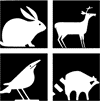Wildlife Damage Management, Internet Center for
Date of this Version
2003
Document Type
Article
Abstract
The National Wildlife Research Center (NWRC), based in Fort Collins, CO, is the research arm for the Animal Plant and Health Inspection Service’s Wildlife Services Program. Its mission is to resolve conflicts between wildlife and humans. The NWRC established a GIS (Geographic Information System) function in 1996. The relevance of GIS to two projects are featured in this poster. Project 1 was conducted in 1996 and was a joint effort between the NWRC and the California Department of Food and Agriculture (CDFA). In this project, 60 Chinese ring-necked pheasants were radio-instrumented and their movements studied. The main goal of the project was to determine if there were primary hazards to pheasants as a result of the application of the rodenticide zinc phosphide in dormant alfalfa for vole management in the northern Sacramento Valley. Through the use of telemetry and GIS, pheasant habitat preferences emerged, and the absence of these birds in dormant alfalfa contributed to the reregistration of zinc phosphide to control voles in this crop. Project 2 was conducted in 2000 under a contract with the Anchorage International Airport Authority. The NWRC was asked to determine bird strike risks to commercial aircraft from waterfowl moving within the Anchorage Basin. Preferred habitats were selected, along with the flight paths of commercial aircraft, to create an area matrix of possible waterfowl-aircraft intersections within which conflict could occur. The potential rehydration of Klatt Bog was a key focus. If the bog was rehydrated, would the airspace around Klatt Bog create a greater risk to aircraft? GIS was used to build a model that represented the conflicted three dimensional airspace at risk, with and without Klatt Bog rehydrated. Boeing 737 and 747 aircraft were selected to represent the upper and lower altitude boundaries during take-off and landing of commercial aircraft. These aircraft were selected after discussion with flight engineers because most other fixed wing commercial and general aviation aircraft fall between the climb characteristics of these two aircraft. Assuming the rehydration of Klatt Bog would increase its suitability as a bird habitat, the conflicted airspace between 501- 3090 feet in elevation was calculated at 27,972.1 x 106 m3 without inclusion of Klatt Bog and 31,814.1 x 106 m3 with the inclusion of Klatt Bog. Thus, the incremental increase in conflicted air space attributable to Klatt Bog was13.73 % (a 0.1 fold increase).



Comments
Published in Proceedings of the 10th Wildlife Damage Management Conference. (K.A. Fagerstone, G.W. Witmer, Eds). 2003.